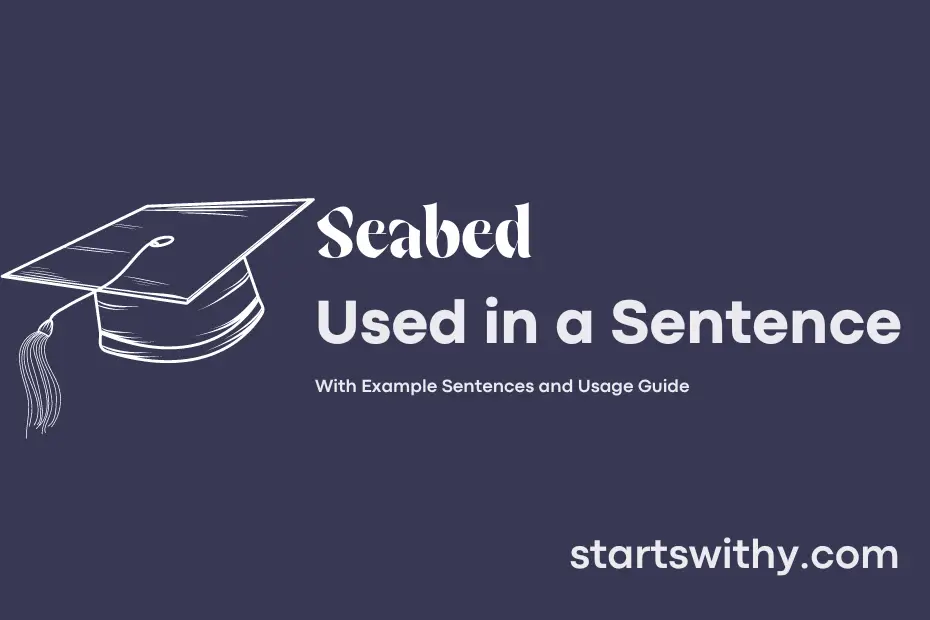Have you ever wondered what lies beneath the ocean’s surface? The seabed, also known as the ocean floor, is the bottom of the world’s oceans and seas. It is a diverse and fascinating landscape that holds many secrets waiting to be discovered.
The seabed is home to a wide variety of marine life and geological features, including coral reefs, underwater volcanoes, and vast plains of sand and sediment. Understanding the seabed is crucial for scientific research, conservation efforts, and even resource exploration. Let’s dive deeper into the mysterious world of the seabed and explore its importance in our understanding of the marine environment.
7 Examples Of Seabed Used In a Sentence For Kids
- The seabed is where many colorful fish live.
- The seabed is like the floor of the ocean.
- Starfish and crabs can be found on the seabed.
- Some treasure chests are hidden on the seabed.
- Seaweed grows on the seabed.
- It is fun to explore the seabed with scuba gear.
- Dolphins swim gracefully near the seabed.
14 Sentences with Seabed Examples
- Seabed exploration is a fascinating field of study that requires advanced technology.
- The biodiversity of the seabed is crucial for marine ecosystems and must be protected.
- Researchers often use ROVs to study the creatures living on the seabed.
- Understanding the geology of the seabed can provide valuable insights into plate tectonics.
- Marine geology courses often cover topics related to seabed mapping and sediment analysis.
- The discovery of ancient shipwrecks on the seabed has helped archaeologists understand maritime history.
- Remote sensing techniques are used to map the topography of the seabed.
- Students studying oceanography learn about the different types of habitats found on the seabed.
- Sediment cores collected from the seabed can provide information about past climate conditions.
- Marine biology students often conduct fieldwork to observe the diverse species that inhabit the seabed.
- The health of the seabed is a critical indicator of the overall condition of the marine environment.
- Conducting research on the seabed requires specialized equipment and training.
- Coral reefs are often found on the seabed and play a vital role in supporting marine life.
- Students interested in marine conservation learn about the impact of human activities on the seabed.
How To Use Seabed in Sentences?
Seabed is the main focus of your sentence when using it. It refers to the bottom of the ocean, typically covered with sand, rocks, and coral. To use seabed in a sentence, start by identifying the context in which you want to talk about the ocean floor.
For example, “The divers explored the colorful coral reefs and vibrant marine life along the seabed.” In this sentence, seabed is used to describe the ocean floor where the divers were exploring.
Another way to incorporate seabed into a sentence is, “Scientists have discovered unique species living in the deepest parts of the ocean seabed.” Here, seabed is used to highlight the specific habitat where the unique species were found.
When using seabed in a sentence, make sure it is placed correctly within the context of your statement to convey the intended meaning. Remember that seabed refers to the bottom part of the ocean and is a specific term used in marine science and geography.
Overall, incorporating seabed into your sentence can add depth and detail to your description of ocean-related topics.
Conclusion
In conclusion, the seabed is the ocean floor, which is home to a diverse array of marine life and habitats. Understanding the different layers of the seabed, such as the sandy bottom or rocky coral reefs, helps scientists and researchers in studying ecosystems, biodiversity, and even predicting natural disasters like tsunamis. By examining sediment samples, mapping submarine features, and monitoring marine life, valuable data can be gathered to aid in conservation efforts and sustainable management of our oceans.
Exploring the seabed not only reveals the hidden wonders of the underwater world but also presents opportunities for scientific discovery and advancements in marine conservation. By studying the intricate ecosystems on the seabed, we can better appreciate the importance of protecting our oceans and preserving these vital habitats for the well-being of both marine life and humans.



